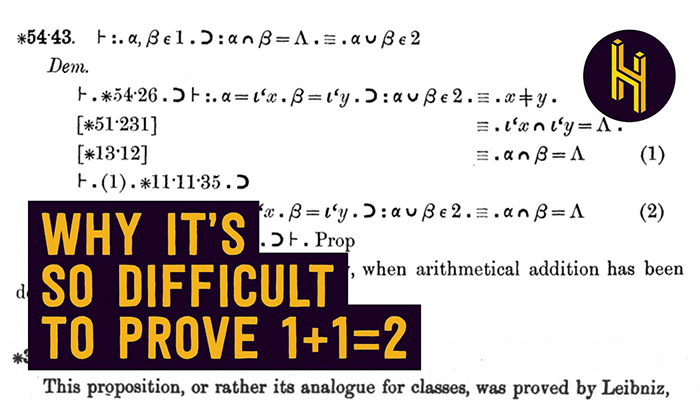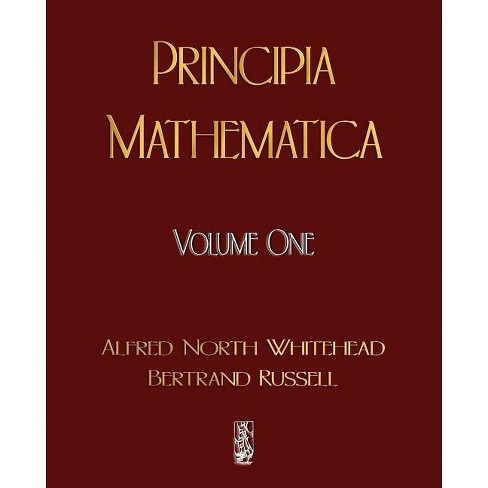Why It Took 379 Pages To Prove 1+1=2. There are few certainties in life, but one thing we can all be sure of, Is that one plus one equals two, or can we? I mean could you prove it? In these pages lies the 379-page proof that one plus one equals two. Now you might be wondering why is there mathematical proof that one plus or one equals two. What does it entail and why is it so long?
The answer to these questions is a fascinating story. It involves a decade-long struggle between two of the greatest mathematicians of the 20th century. Groundbreaking ideas that make us question. The nature of mathematics and one of the most epic failures in history. To understand why proof that one plus one equals two even exists, we need to travel back to ancient Greece.
In the fourth century BC, mathematics was largely made of just two fields. Geometry is the study of shapes, and arithmetic is the study of numbers. A famous Greek mathematician named Euclid thought mathematics was the language that described our universe. Statements like the angles of every triangle add to 180 degrees and two parallel lines never meet, were observable facts of our world.
Mathematics was the purest form of knowledge. It couldn’t have inconsistencies, because that would mean the universe we lived in had inconsistencies. Euclid thought that geometry was the embodiment of mathematical truth and came up with five axioms that all of the geometry was built. We knew what math was and we knew how it worked.
It was neat and tidy, pure and perfect, but over time things started to take a turn. Sure, math was simple when it was made up of just shapes and numbers, but over the years more complicated fields started to join the party. Abstract ideas like infinity and imaginary numbers challenged our intuition. Furthermore, no one knew how all these fields fit together.
As a new branch of math was developed it was kind of just tacked on somewhere. As with all poorly built things, cracks started to emerge. By the 1900s, mathematics was riddled with paradoxes, the most famous being Russell’s Paradox, which I’ve made a video about if you’d like to learn more. Perhaps the biggest blow to mathematics was the discovery of non-euclidean geometry.
You see, Euclid’s five axioms ranged supreme for over 2000 years, but one of them had always caused some trouble, the fifth axiom. Given a line and a point not on it, of all the lines drawn through the point, at most one can be parallel to the original line. It was different from the other four, it seemed clunky, and less self-evident. Mathematicians decided to experiment with what would happen if they simply got rid of it.
Would Euclidean geometry still work or would it collapse? What would happen if we let many lines be parallel to a given line or none at all? No one could have expected the results. Entire new geometries were born, different from anything we see in the real world. Triangles whose angles add to more than 180 degrees, surfaces with only one side, and objects in fractional dimensions.
And the craziest thing was, they were all completely consistent, with not one paradox to be found. These new geometries were very imaginatively called, non-euclidean geometries, and they completely destroyed our conception of what math was. We thought math was the language that described our universe, but these geometries existed in a universe of their own.
The discovery of non-euclidean geometry, combined with the increasing number of paradoxes popping up, shook the foundation of mathematics to its core. If we weren’t careful, the entire structure would collapse. Something needed to be done. But what? Here enter the tragic heroes of our story. Two mathematicians, Bertrand Russell and Alfred North Whitehead took on the challenge of taming the mathematical beast.
The two men brought different things to the table. Whitehead, age 38, was an established Cambridge academic, with expertise in algebra and geometry. Russell, a decade younger, had studied mathematics as an undergrad and despite his young age had already published books, ranging from the foundations of geometry to German social democracy.
Russell thought about the important questions of mathematics lying at the very beginning and the further back we could go, the better we could understand the nature of mathematics. He wrote the most obvious and easy things in mathematics are not those that come logically at the beginning. They are the things that come somewhere in the middle, just as the easiest bodies to see are those that are not very near nor very far.
The easiest conceptions to grasp are those that are neither very complex nor very simple, and as we need two sorts of instruments, the telescope and the microscope for the enlargement of our visual powers, so we need two sorts of instruments for the enlargement of our logical powers. One to take us forward to higher mathematics and one to take us backward to the logical foundations.
Their plan was to knock down this ancient structure and build an entirely new framework of mathematics from the ground up. A utopia is free of paradoxes and contradictions. This project manifested itself as a giant three-part volume called Principia Mathematica. This is just volume one, so imagine this times three. In these pages, they laid the foundations needed to prove that one plus one equals two.
So you might be starting to understand why the proof is so long. Russell and Whitehead weren’t just trying to prove that one plus one equals two. They were rebuilding 2000 years of mathematics. This is such a monumental task. Where would you even start? Well, like when building anything, you need a strong foundation. So what would make a strong foundation for mathematics? Russell and Whitehead believed logic was the answer.
Many mathematicians believe that logical knowledge is the greatest kind of knowledge. That knowledge based on pure reason is somehow more true than knowledge based on the observations of the world around us. Logical knowledge is different from other types of knowledge for a couple of reasons. For one, logical statements are true because of their form rather than because of their content.
For example, the statement, I will eat this piece of cheese or I will not eat this piece of cheese is just true. Not only is it true, but there is no possible world in which it is false. We also know it’s true, without needing to do any investigating or in fancy talk, it’s true a priori.On the other hand, we can’t know whether the statement, this cheese is made from goat’s milk, is true without doing some research.
This statement is true a posteriori. Russell and Whitehead wanted to build a system of logic that was powerful enough to describe all of mathematics. They wanted it to be airtight, free from paradoxes and false results. Now about the question of what exactly mathematics is. We learned from non-euclidean geometry that math isn’t grounded in reality and that we couldn’t discover its truths by observation.
There had been talking among mathematicians that the way to think about math was more like a game where we invented the rules of the game and discovered the results. Choose different rules and play a different game. Brussel and Whitehead thought that the way to create the perfect game of mathematics was to write the ultimate set of rules that didn’t allow for any contradictions.
This mathematical philosophy is known as formalism and at its heart is the idea of a formal system. A formal system is an airtight way of showing proof. It consists of three things, formal language, logical axioms, and rules of inference. A formal language is the building block that their mathematics would be made of. To do any kind of math, we need to manipulate symbols.
So naturally, we need to decide what those symbols will be, what their meanings are, and how they relate to each other. In the Principia Mathematica, the formal language looked like this. Next, we have axioms. Axioms are statements on which all other statements are built. They serve as a starting point.
They are statements that are so obvious and self-evident that they don’t need proof. Now you might think that a statement, like one plus one, equals two, is so obvious that it could be an axiom. But in fact, the statement one plus one equals two has a plethora of assumptions baked into it, which will unearth later in the article.
To show you just how far back Russell and Whitehead went, some axioms of Principia Mathematica are, if P is true is a valid statement, then P is false is also a valid statement. And if you have a valid statement, it is either true or false. And finally, to build more mathematical statements or theorems up from axioms, we need logically sound rules of inference.
These are like the pillars in the house of mathematics, how we get from one statement to the next. They serve as indestructible links in a chain of reasoning. Some rules of inference from Principia Mathematica are: if the statement P is false, then P is true. And if A or B is true, then B or A is also true. The idea was that by building a foolproof foundation, then coming up with foolproof instructions for adding onto the foundation, the entire structure would be foolproof.
With this combo of foolproofers, there was no way for paradoxes and contradictions to sneak in. Each theorem of mathematics would consist of an airtight proof from start to finish. Russell and Whitehead thought the project might take a year to complete, but it ended up taking a decade just to cover arithmetic. The authors struggled greatly with the project, both mentally and personally.
In a letter from 1916, Russell told an anecdote about an experience he had with his student Wittgenstein. I saw he was right and I saw that I could not hope ever again to do fundamental work in philosophy. Wittgenstein persuaded me that what wanted to do in logic was too difficult for me. I feel you, Russell.
The project was so all-consuming, that Russell and his wife Alice even moved in with the Whiteheads at one point, but Russell became infatuated with Whitehead’s young wife, Evelyn, and his own marriage suffered. It might have taken longer than a decade, but Whitehead insisted that they publish the work, even though it wasn’t complete.
Now, after everything we’ve talked about, you might think that publishers would be excited to publish this masterpiece. It’s basically a book claiming to be the Bible of Mathematics. But no publisher would touch it and Russell and Whitehead had to give money out of their own pockets to get it published. And you know, after trying to read this thing, I can understand why it’s so hard to read.
It’s filled with pages and pages of obscure symbols and the writing is so dense that after I’d finished a paragraph, I really had no idea what it was about. The mathematician Steven Wolfram wrote in his blog, I do not know if Russell and Whitehead intended Principia to be readable by humans, but in the end, Russell estimated years later that only six people had read the whole thing.
After a week of trying, I am not one of those six people. Anyway, the Principia Mathematica was finally published in 1910, and although our heroes were exhausted, at least they could lie back and bask in the glory of having fixed all of the math problems, right? Well, no, it was a failure. But before we talk about why it was a failure, I feel like this article wouldn’t be complete without talking about what kind of ideas are involved specifically in the proof that one plus one equals two.
What assumptions are we making when we look at this statement? Identifying our own assumptions can be a tricky business, so I find it helpful to imagine explaining it to an alien. That alien is smart, and extremely logical, but doesn’t know any of our history or syntax. When it’s presented with this statement, it just sees a bunch of symbols.
These symbols don’t carry any inherent meaning, any meaning they do have been given to them by us. So what do the symbols represent? Well, you say this one represents the number one and this one represents the number two. This one represents equal to and this one represents a plus. So the alien asks, what is the number one? You hold up one finger and say this is the number one.
Then the alien says, oh okay, a finger is the number one. Of course, this isn’t true, so you try again. You hold up one capybara and say, this is the number one, and the alien says, oh okay, a capybara is the number one. This is trickier than you thought. How do you describe number one? You can’t exactly point to anything in the real world and say that is number one.
To answer this, Russell and Whitehead turned to the idea of a set. A set roughly speaking, is a collection of things. For example, the set of all capybaras contains all the capybaras that have existed past, present, and future. The set of all pieces of cheese on this table consists of five pieces of cheese on this table. In the Principia Mathematica, Russell and Whitehead defined the number one as the set of all sets that have this many elements in them.
The number two was the set of all sets with this many elements in them. The number three was the set of all sets with this many elements in them, and so on. According to Russell and Whitehead, a number can be represented by a set, and we distinguish between numbers by how many elements are contained in the sets representing them.
So you say to the alien, the number one is what all of these sets have in common, and the number two is what all of these sets have in common. Now we’re getting somewhere. You decide to move ahead. You say that the number one added to the number one is equal to the number two, but then the alien asks, what does it mean for two numbers to be equal? Russell and Whitehead defined two numbers to be equal, if you can match every element of a set with every element of another set, with no elements left over.
There’s a bit more to it than that, but that’s the basic gist. On page 379, after the proof is stated, the author’s note, from this proposition will follow, when arithmetical addition has been defined, that one plus one equals two. Oh yeah, Russell and Whitehead still hadn’t defined addition. So I guess technically the proof is incomplete. Our heroes plan to publish another volume.
But just a few years after Principia Mathematica was published, a mathematician named Kurt Godel showed that no formal system of mathematics, especially theirs, could be both consistent and free of contradictions. This was a huge blow to Russell and Whitehead, as it basically nuked the entire premise of Principia Mathematica.
This result is known as Godel’s Incompleteness Theorem. Russell and Whitehead were so defeated that Russell gave up on mathematics and turned to politics instead. And that is the story of why it took 379 pages to prove that one plus one equals two. One message from this story is that the way information is presented is so important.
Here Russell and Whitehead couldn’t find a publisher for their masterpiece, because it was too difficult to understand. There are so many fascinating ideas buried in these pages, but I could only access them by working through resources online. One of these resources was Brilliant’s course on logic. It’s difficult to imagine how Russell and Whitehead derived all of mathematics from a small set of simple rules, but that’s what makes logic so fascinating.
This course made me understand how so much can be derived from so little. I like Brilliant because I find it difficult to stay engaged through passive reading. And Brilliant places a huge emphasis on story and problem solving, whether it be helping robots run a theme park, getting a lying Android to tell you the truth, or seeing how logic is applied to artificial intelligence.
Read Related Articles-
Betelgeuse – Largest Planet in the Universe
Moon Landing Mystery | The Apollo 11 Beautiful Story With Proof
Wormholes Explained – Breaking Spacetime | What is Wormhole?
How do you create a personal brand that you are proud of?
Most Beautiful Women in the World 2022 | Top 20
Most Beautiful Transgenders in Thailand
Visit Our Online Shop Website- WWW.CEYLEBRITY.COM
Ceylebrity Sinhala News And Articles- WWW.CEYLEBRITYNEWS.LK
Knowledge World Blog- WWW.KNOWLEDGEWORLD.BLOG
Share






